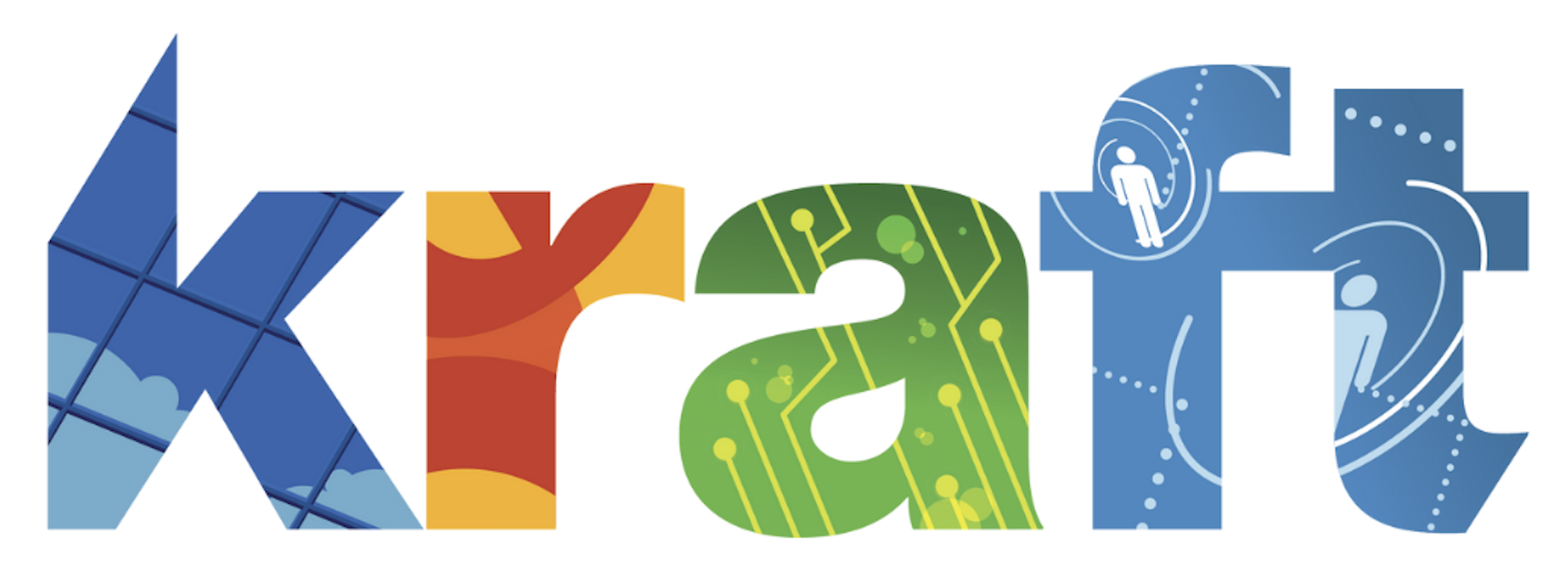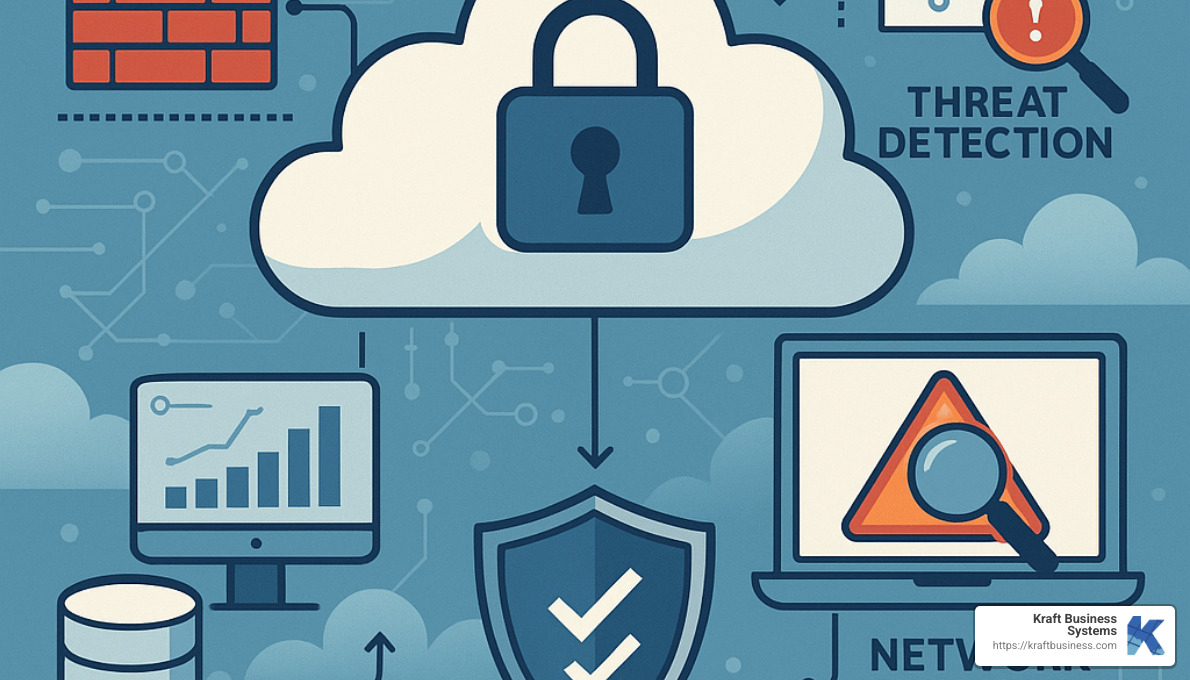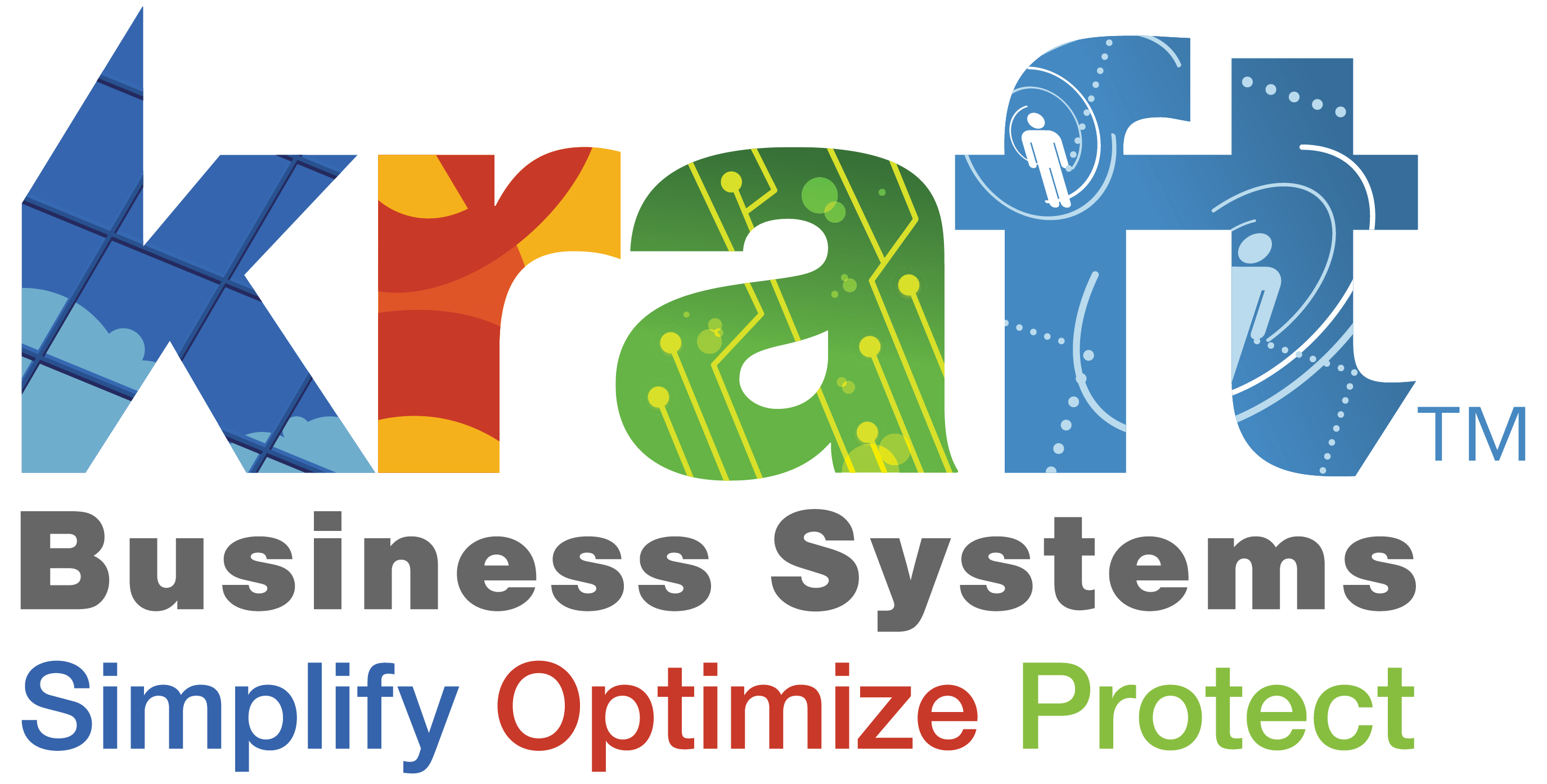Why Cloud Security Monitoring Solutions Are Essential for Your Business
Cloud security monitoring solutions are tools designed to continuously scan and analyze your cloud-based systems, applications, and data to detect security threats in real-time, spot vulnerabilities, and ensure compliance with industry standards.
Quickly, here’s what these solutions can do for your business:
- Continuous Monitoring: Constantly watch cloud environments to catch threats early.
- Real-Time Threat Detection: Instantly spot unusual activities or potential security breaches.
- Compliance Assurance: Help maintain compliance with regulations like PCI DSS, HIPAA, and GDPR.
- Increased Visibility: Provide a clear overview across multiple cloud platforms, reducing blind spots.
- Rapid Response: Quickly alert you so threats can be addressed immediately.
As a business owner, your cloud environments hold sensitive information crucial to your operation—ignoring security can lead to costly consequences. Just recently, the genomics company 23andMe reported that data from about 6.9 million users was exposed due to a security breach, highlighting why proactive cloud security is critical.
In this guide, we’ll dive deeper to help you understand how cloud security monitoring solutions can protect your business data and keep your operations safe.
Understanding Cloud Security Monitoring
Cloud security monitoring is all about continuously keeping an eye on your cloud resources to spot threats, vulnerabilities, and compliance risks. Think of it like having a reliable guard dog for your cloud systems—always alert and ready to bark when something suspicious pops up.
As businesses throughout Michigan (and beyond!) keep moving their operations to the cloud, safeguarding these environments becomes critical. Simply put, cloud security monitoring involves both automated tools and manual efforts to regularly review and assess the security of cloud servers, applications, platforms, and websites. It’s a proactive approach, not just sitting back and hoping nothing goes wrong.
You might be surprised to learn that the cloud monitoring market is booming—valued at nearly $2.2 billion in 2023 and expected to hit almost $10 billion by 2030. That’s an annual growth rate of 24.1%! Clearly, organizations are realizing they can’t afford to skip or skimp on cloud security.
At its heart, cloud security monitoring focuses on several key areas:
First, there’s metrics monitoring, which means tracking things like CPU usage, memory utilization, disk operations, and network traffic. Sudden spikes or unusual patterns in these metrics can often signal a security issue or an attack.
Next up is log monitoring. Every cloud resource generates logs that keep track of activity—like user logins, configuration changes, or access attempts. Monitoring these logs helps quickly identify suspicious behavior, unauthorized access, or incorrect configurations.
Another essential area involves keeping tabs on general performance indicators. This includes checking system response times, availability, or service disruptions—because when something’s not performing as expected, it could mean there’s a hidden security threat at play.
For businesses around Grand Rapids and across Michigan, robust cloud security monitoring isn’t just a nice-to-have; it’s a must-have. Keeping your data safe and your business running smoothly depends on consistently spotting and fixing issues before they escalate.
Key Components of Cloud Security Monitoring
Effective cloud security monitoring isn’t a single step; it’s more like a well-tuned orchestra, with multiple parts working harmoniously together.
It all starts with data collection and aggregation. This involves systematically gathering information from every corner of your cloud infrastructure—application performance metrics, network traffic details, user access logs, and records of configuration changes. For businesses using hybrid or multi-cloud setups, centralized data collection ensures there’s no place for threats to hide.
Once you’ve gathered all that information, it needs to be carefully examined through automated analysis. Cloud security monitoring solutions use smart and sophisticated tools to recognize patterns, pinpoint anomalies, and detect potential threats. They rely on behavioral analysis (spotting activities that don’t match typical behavior), event correlation (linking different system actions that might indicate a broader threat), pattern recognition (identifying known attack methods), and even machine learning (getting smarter and more accurate over time by learning from past data).
Now, if something fishy does pop up, you definitely don’t want to find out days later. That’s why good cloud security monitoring solutions provide real-time alerts, letting you know immediately when potential issues arise. Notifications can be customized based on severity, sent through channels like email or SMS, and even integrated into your team’s communication tools. Alerts typically include context to help your security folks understand and prioritize what’s happening quickly.
Another critical area is compliance checks. Whether you’re dealing with HIPAA, PCI DSS, GDPR, or other standards, your cloud security monitoring solution regularly verifies that your cloud setup meets all necessary regulations. It also documents compliance status clearly, making audits far less stressful.
Of course, identifying threats is just one half of the equation—you also have to fix them. That’s where remediation actions come in. Modern cloud security monitoring solutions can automate responses to common problems, integrate with incident management platforms, and guide security teams step-by-step through handling more complex issues.
Finally, there’s the essential piece of comprehensive reporting. A good solution doesn’t just throw data at you—it provides clear and understandable insights into your overall cloud security status. Securing buy-in from executives is easier when they can see straightforward dashboards, while your security teams benefit from detailed technical reports. Compliance reports also simplify tracking and demonstrating adherence to regulations.
By integrating all these capabilities into powerful cloud security monitoring solutions, Michigan-based businesses can confidently protect their cloud environments, maintain compliance, and rest easier knowing their critical data is secure.
How Cloud Security Monitoring Works
Understanding the mechanics of cloud security monitoring helps businesses appreciate the value these systems provide in protecting their data and infrastructure. Let’s explore the process that makes these solutions effective.
The Cloud Security Monitoring Process
Think of cloud security monitoring as a continuous protective cycle rather than a one-and-done setup. The process flows naturally from one step to the next, creating a shield around your business data.
First, everything starts with data aggregation. Your monitoring system gathers logs from all over your cloud infrastructure – servers, containers, applications, you name it. For Michigan businesses using multiple cloud providers like AWS, Azure, or Google Cloud, this creates a complete picture instead of fragmented views.
Once gathered, this data flows into automated threat analysis engines. This is where the real detective work happens. Rule-based systems catch known threats (like a security guard who recognizes a known troublemaker), while anomaly detection spots unusual behavior (like noticing someone in your office at 3 AM). More sophisticated systems use machine learning to identify subtle patterns that might indicate clever attacks, and behavioral analysis compares current activities against what’s normal for your business.
When something suspicious pops up, real-time notifications kick in. These alerts get sent based on how serious the threat might be. Your team can receive these alerts through email, text messages, or even directly in tools like Slack or Microsoft Teams – ensuring nobody misses critical security information.
While all this happens, the system performs continuous compliance checks. It’s like having someone constantly making sure your doors and windows are locked, confirming your cloud configurations match required security frameworks and best practices.
When issues are found, remediation actions can begin immediately. Some systems can automatically fix common problems, while others guide your team through the necessary steps to address more complex threats.
Finally, visibility and reporting tools give your team clear insights into your security status. These dashboards and reports help both technical staff and management understand threats, trends, and where your security stands.
For businesses in Grand Rapids, Detroit, Lansing, and throughout Michigan, this ongoing cycle provides protection against threats that might otherwise remain hidden until damage is already done.
Cloud Security Monitoring Solutions and Their Role
Cloud security monitoring solutions combine multiple security functions into unified platforms that work together to protect your business. They’re the central hub of your cloud security strategy.
One of the biggest benefits is unified visibility across environments. Most businesses today don’t operate in just one cloud – they have resources spread across public clouds like AWS or Azure, private infrastructure, and hybrid setups. Cloud security monitoring solutions eliminate blind spots by giving your team a single view into everything. This is especially valuable for Michigan businesses that have grown through mergers or gradually expanded their IT footprint, resulting in complex multi-cloud environments.
These solutions don’t work in isolation – they play well with others. Good cloud security monitoring solutions integrate smoothly with your existing security tools and processes. They connect with your SIEM systems, identity management, endpoint protection, network security tools, and even your development pipelines. At Kraft Business Systems, we help Grand Rapids businesses implement security that works with what you already have, rather than forcing you to start from scratch.
What really makes modern cloud security monitoring solutions powerful is their advanced threat detection capabilities. They use AI and machine learning to spot unusual patterns that traditional security might miss. They analyze behavior to catch compromised accounts, scan for vulnerabilities before attackers find them, audit configurations to spot security gaps, and tap into threat intelligence to identify known bad actors.
These capabilities work together to help Michigan businesses detect and respond to threats that simpler security measures would miss entirely. With the right cloud security monitoring in place, you gain both peace of mind and practical protection for your critical business data.
Benefits of Cloud Security Monitoring
When it comes to protecting your business in the cloud, a proactive approach is the best defense. By adopting robust cloud security monitoring solutions, you’ll enjoy some valuable benefits that go far beyond basic data protection. Let’s explore a few ways these solutions positively impact your business.
Strengthened Security Posture
The most immediate advantage of implementing cloud security monitoring is improving your organization’s overall security posture. With continuous monitoring, you can catch threats early, often before they escalate into serious security breaches. This early detection capability helps reduce your organization’s attack surface by quickly spotting misconfigurations, vulnerabilities, or unusual activities that could otherwise be exploited by attackers.
What’s even better is that automated remediation capabilities built into these solutions help to swiftly resolve security issues, shortening your exposure time and minimizing damage. And because these systems offer comprehensive visibility across all your cloud environments, you’ll eliminate those pesky blind spots that leave your business vulnerable.
As a Principal Segment Lead for Security at AWS points out, cloud security monitoring turns massive amounts of log information into actionable intelligence—helping your security team stay one step ahead of threats without becoming overwhelmed.
Extended Uptime and Business Continuity
No business enjoys downtime—especially when that downtime results from security incidents. Fortunately, cloud security monitoring solutions help you maintain consistent uptime and keep your business running smoothly.
With constant monitoring, you’ll proactively prevent security-related outages by quickly detecting and solving issues before they impact your services. Even when incidents do occur, real-time alerts help you rapidly respond, significantly minimizing downtime and disruptions.
Continuous monitoring also means you’re observing both performance and security metrics, so your operations stay reliable, accessible, and secure. And let’s face it: no one likes explaining outages to customers or dealing with the damage to reputation that can come from security breaches. For businesses across Michigan—from busy manufacturers in Detroit to tech innovators in Grand Rapids—reliable service isn’t just a good idea; it’s essential.
Reduced Data Breaches and Associated Costs
Let’s talk about money (and stress!). Did you know the average cost of a data breach is a whopping $4.24 million, according to IBM? It’s no wonder businesses everywhere are working hard to avoid that scenario. Implementing effective cloud security monitoring significantly reduces your risk of costly breaches.
By continuously monitoring for any unusual activity, you’ll quickly spot unauthorized access attempts and data leaks before they become full-blown disasters. Early detection allows your security team to limit the scope of a breach, dramatically reducing the potential damage and associated costs.
Plus, compliance checks baked into these solutions help you prevent penalties from data protection regulations like GDPR, HIPAA, or PCI DSS. One Security Engineer at Bitstamp noted their cloud security monitoring solution enabled rapid threat hunting, allowing them to run 156 IOC searches efficiently over just a few months.
Optimized Security Metrics and Decision-Making
Finally, cloud security monitoring gives you valuable insights to make smarter security decisions. Instead of relying on guesswork, your team can use real-time data and trends to improve your overall security strategy.
By regularly analyzing security trends, you’ll clearly identify recurring issues that need strategic attention. This allows you to allocate your resources more effectively, putting your security investments exactly where they’re needed most.
Additionally, the data provided by these solutions supports risk-based decision-making, helping leaders confidently quantify and manage the organization’s security risks. This clarity also ensures continuous improvement, as you’ll be able to measure how effectively your security controls and processes perform over time.
A VP of Security and Platform Abuse at Dropbox remarked that cloud security monitoring solutions allowed their company to proactively enforce secure configurations across their cloud services. Daily scans and real-time alerts for compliance issues or suspicious activity transformed their approach to security from reactive firefighting to proactive prevention.
Want to dive deeper into the benefits cloud security can bring your business? Check out our resource on Cloud Security for Businesses to learn more.
Challenges in Cloud Security Monitoring
Cloud security monitoring solutions offer fantastic protection for your cloud environments—but let’s be honest, implementing them isn’t always a walk in the park. Like any good thing, there are a few problems to clear along the way. Being aware of these challenges upfront can help you prepare and overcome them.
Lack of Visibility Across Multi-Cloud Environments
One of the trickiest parts of cloud security monitoring is simply keeping an eye on everything. Businesses today often use multiple cloud providers like AWS, Azure, and Google Cloud. Each platform runs things a little differently, making it tough to get a unified view of your entire security landscape.
On top of that, your team might be dealing with shadow IT, where employees start using cloud services without the IT team’s knowledge. (Hey, we get it—sometimes those shiny new apps are hard to resist!) But these “under the radar” activities can create serious blind spots for security.
Then there are those legacy systems from your on-premises days, hanging around like your favorite old sweater. Incorporating those systems into cloud security monitoring can be complicated—yet it’s a crucial step for comprehensive protection.
And let’s not forget those trendy, modern deployment methods like containers and serverless environments. They’re fantastic for productivity but can cause headaches when it comes to visibility. With so many moving parts, it’s easy to miss misconfigurations—leading to real problems down the line.
Clearly, the visibility struggle is real.
Alert Fatigue from Excessive Security Notifications
Ever had so many notifications on your phone that you ended up ignoring all of them? That’s what alert fatigue looks like in cloud security monitoring.
Cloud environments generate a crazy amount of security alerts every day. Worse yet, a big chunk of these are usually false alarms—benign activities flagged as threats. This high false positive rate can quickly become overwhelming, especially for small to mid-sized businesses here in Michigan that might not have a large security team.
Knowing which alerts truly matter gets tricky too. Setting proper priorities can feel like chasing a moving target. And if your business uses multiple security tools, each with its own alert system, the volume can skyrocket fast.
As one senior security architect described it, “Cloud security monitoring helped us deal with this firehose of information we were getting—it took us from hundreds of alerts a day down to just a handful.” Clearly, finding a way to tame the alert beast is crucial for staying sane (and secure).
Difficulty Detecting Insider Threats
When we think of security threats, most of us picture shady hackers in dark hoodies. But sometimes the threats come from inside the house (cue spooky music). Insider threats can mean well-intentioned employees making innocent mistakes—or they might be disgruntled team members with malicious intent.
Either way, catching these threats is tricky. After all, insiders have legitimate access to your cloud resources, so distinguishing between normal activities and suspicious ones is tough. Plus, insiders usually know the systems well enough to cover their tracks or avoid detection altogether.
Spotting these threats means closely tracking user behavior, but establishing clear behavioral baselines can be a hassle. And let’s be honest, nobody likes feeling as though Big Brother is watching their every move—so privacy concerns also come into play.
Scalability of Cloud Security Monitoring Solutions
As your business grows, your cloud environment does too. And sometimes what worked for a smaller setup becomes difficult when scaled up.
More cloud resources mean more log data—mountains of it. Your monitoring tools need to efficiently process all that data without slowing down your cloud applications or breaking your budget. Expanding monitoring capabilities also increases deployment complexity, adding pressure on your IT team.
Scalability isn’t just about adding more resources—it’s about doing so smartly, so performance doesn’t suffer, and costs stay manageable. For growing businesses in places like Grand Rapids, Lansing, or Ann Arbor, having scalable cloud security monitoring solutions is critical to support future growth.
Multi-Cloud Complexities
Operating in a multi-cloud setup is pretty common nowadays—and it has its perks. But it also comes with some serious security complications. Different cloud providers have inconsistent security controls, meaning features available on one platform might not exist (or work differently) on another.
Not only are the native monitoring tools wildly varied across providers, but managing identities and access (identity management) becomes especially complex. Ensuring compliance across different platforms takes specialized knowledge so you can avoid unexpected fines or penalties from regulatory mistakes.
At Kraft Business Systems, we’ve helped Michigan businesses steer these multi-cloud complexities by implementing integrated cloud security monitoring solutions. By providing a unified, streamlined view, we make multi-cloud security both manageable and effective.
Best Practices for Implementing Cloud Security Monitoring Solutions
Successfully implementing cloud security monitoring solutions doesn’t have to be overwhelming. Here at Kraft Business Systems, we’ve guided many Michigan businesses through the process, and we’re happy to share some practical tips to make your own implementation smooth, effective, and stress-free.
Define Clear Monitoring Objectives
First things first—before diving into tools and technology, clearly define what you want your monitoring to achieve. Think about your most critical assets, data, and business areas: what’s most important to protect? Identify the compliance frameworks (like HIPAA or GDPR) relevant to your industry, and figure out the metrics you’ll use to measure success. Setting clear expectations for response times and remediation can also avoid confusion later on.
The best cloud security monitoring solutions are custom to your business. Defining objectives upfront helps to ensure you pick the right tools and processes to keep your environment secure.
Evaluate Cloud Service Providers Carefully
Not all cloud providers offer the same level of built-in security. Take time to carefully evaluate security features and certifications each provider offers. Understand their shared responsibility model—what they protect and what’s your responsibility—and review their security documentation to ensure they’re a fit for your security goals.
Doing your homework upfront can avoid headaches (and security breaches!) down the road.
Enable Full-Stack Coverage
Comprehensive coverage is key. Make sure your monitoring covers every layer of your cloud environment, from infrastructure (like virtual machines and storage) to platforms (databases and containers), applications (APIs and software), and even the data itself (how and when data is accessed or moved).
Having full-stack coverage eliminates those pesky blind spots that cyber attackers love to exploit—and nobody wants to be the easy target.
Automate Cloud Security Monitoring
Automation is your best friend in cloud security. It helps your team stay vigilant without getting bogged down in endless manual tasks. Automate vulnerability scans, configuration checks, and critical security alerts. Even better, set up automated remediation workflows for common issues, so your team can focus on other important tasks.
Automation doesn’t replace human oversight, but it sure makes your security team’s lives easier (and lets them sleep better at night).
Perform Regular Manual Security Inspections
Automation is powerful, but it doesn’t catch everything. Regular manual inspections still matter. Consider scheduling periodic penetration tests and security architecture reviews. Manually reviewing high-risk security alerts adds an extra layer of protection, and regular assessments by qualified security professionals can help spot issues automation might miss.
Think of automation and manual inspection as a dynamic duo—they’re great on their own, but unbeatable together.
Integrate Alerts with Existing Workflow Tools
Security alerts aren’t useful if nobody sees or responds to them quickly. Integrate your cloud security monitoring solutions with the workflow tools your team already uses. Connect monitoring systems with ticketing platforms like ServiceNow or Jira, or communication tools like Slack or Microsoft Teams. Be sure your alerts are mobile-friendly and have clear escalation paths for critical issues.
Integration means fewer missed alerts and faster response times—which is always a win.
Promote Intelligence Sharing Across Teams
Security isn’t just a job for the IT team—it works best when everyone collaborates. Break down silos by creating shared dashboards that give security, operations, and development teams relevant insights. Set up cross-functional incident response processes and use SIEM platforms to centralize security data.
When everyone communicates and shares information, potential threats don’t slip through the cracks. Plus, teamwork makes security more enjoyable for everyone involved (and might just earn you some office brownie points).
Balance Security with Compliance Monitoring
Security threats aren’t the only thing your monitoring should cover—compliance is equally important. Be sure your monitoring controls map clearly to compliance requirements. Automate compliance reports wherever you can, and keep solid records in case of audits. It’s also crucial to stay updated on changing regulations, ensuring your monitoring evolves alongside compliance requirements.
Balancing security and compliance might feel tricky, but it’s easier than dealing with non-compliance penalties or fines.
Commit to Continuous Improvement
Cloud security monitoring isn’t a “set-it-and-forget-it” solution. Keep your monitoring fresh by regularly adjusting alert thresholds to reduce false positives. Update detection rules frequently as new threats emerge, and always incorporate lessons learned from security incidents. Stay alert to new features or capabilities provided by your monitoring tools as they evolve.
Security threats are always changing, so your security monitoring solutions should too. Continuous improvement keeps you one step ahead of potential attackers.
A Director of Security once joked, “Good cloud security monitoring is the nucleus of our program—without it, our strategy would fly apart.” (We appreciate a good science joke around here.)
By following these best practices, Michigan businesses—from tech startups in Ann Arbor to manufacturing giants in Detroit—can confidently deploy effective cloud security monitoring solutions. You’ll protect your assets, simplify security operations, and maybe even sleep a little better at night knowing your cloud is in good hands.
Selecting the Right Cloud Security Monitoring Solutions
Choosing the right cloud security monitoring solutions for your business is a big decision—but it doesn’t have to be intimidating.
Start by checking comprehensive monitoring capabilities—make sure your solution covers every cloud provider and service you use, including any hybrid, container, or serverless environments. APIs are a common target, so your chosen solution should monitor them as well.
Integration and compatibility are also vital. Look for solutions that easily connect with your existing security tools and support custom integrations. API-driven architectures, pre-built integrations, data export capabilities, and seamless identity management integrations can make your life much easier.
Scalability and flexibility matter too. As your business grows, your monitoring solution should keep pace without slowing down or hurting your budget. Make sure you understand exactly how the solution scales and what the associated costs might be down the road.
Alerting and reporting features should make security info easy to digest. Look for customizable alerts, clear dashboards, and automated reporting tools that simplify compliance and executive communications.
Finally, don’t overlook the value of AI and machine learning. These technologies greatly improve monitoring solutions, enabling anomaly detection, behavioral analysis, and even predictive capabilities to help you stay ahead of threats.
Here at Kraft Business Systems, we assist businesses across Grand Rapids and throughout Michigan in selecting and implementing the ideal cloud security monitoring solutions for their unique environments. For more insights on integrating cloud security into your broader IT strategy, check out our resource on Cloud Integration Strategies for MSP.
Choosing the right monitoring solution is an investment worth making—your cloud’s security (and your peace of mind) will thank you.
Conclusion
Throughout this guide, we’ve explored why cloud security monitoring solutions have become a must-have for businesses of all shapes and sizes. Cyber threats keep evolving, and cloud environments grow ever more complex. That means businesses need continuous, proactive monitoring—not just occasional check-ups—to keep their data safe and sound.
The numbers back this up: by 2030, the cloud monitoring market is set to hit nearly $10 billion. And with the average data breach costing companies a whopping $4.24 million, it’s clear that strong monitoring isn’t just nice-to-have—protecting your bottom line and your reputation.
Here in Michigan, whether your business is part of Grand Rapids’ thriving tech community, Detroit’s proud manufacturing heritage, or Ann Arbor’s vibrant research and development scene, cloud security monitoring gives you the visibility and control you need to safeguard your operations. It helps you keep threats at bay while freeing your team to focus on innovation and growth.
You’ve learned that to effectively guard your cloud environments, you need comprehensive visibility across multi-cloud and hybrid setups. It’s also clear how automation and artificial intelligence play a huge role—they help catch threats faster and cut down on those pesky false alarms that drive security teams nuts. Integrating monitoring with your current tools and workflows boosts efficiency, while committing to continuous improvement ensures your defenses stay sharp, even as threats evolve.
At Kraft Business Systems, we genuinely understand the unique challenges and opportunities facing Michigan businesses. Our friendly, experienced team works alongside companies right here in our backyard, implementing customized cloud security monitoring solutions that fit your business perfectly. We make sure you get robust, reliable protection without bogging down your operations or stifling your creativity.
Good security monitoring always starts with a clear understanding of what you’re protecting. Our experts help you pinpoint your most valuable assets, evaluate your current security posture, and choose the right monitoring solutions to gain the visibility and proactive control you need. And because security doesn’t stand still, we ensure your defenses continually adapt to meet changing needs and threats.
Cybersecurity can seem daunting—but with the right partner cheering you on, it doesn’t have to be. Kraft Business Systems is here to help you confidently secure your cloud environments, leaving you more time to grow your business (or finally take that long-overdue coffee break).
Want to learn more about how we can help protect your business with custom cloud security? Be sure to check out our Cloud Security Services and see how we can support you every step of the way.











